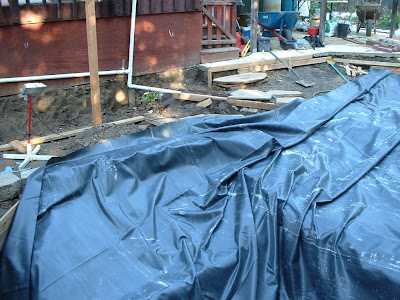For this I am going to assume you have already filled in the pool, dug out your pond, and installed the pump and plumbing.
Preparation:Make sure all loose objects are removed. This includes dirt clumps, bits of rock and concrete, and anything that could possibly poke a hole over time. Next, you should put down sand. Put enough to cover any irregularities to make a smooth surface for the liner. Lastly, some kind of underlayment to protect the liner is highly recommended. Having dealt with a liner pool for so many years, I know this step should not be overlooked.
I used 5(6 including sand) different materials for my underlayment. All of these would have just ended up in the landfill. Most people should be able to improvise by reusing potential trash or something that is just laying around. If you don't have anything, there are many resources on the internet and locally to find what you need. So why purchase an underlayment? Don't listen to pond supply merchants, they make all kinds of claims that are over exaggerated or completely false. I read an article(somewhere on the internet) where some guy was saying that using carpet for underlayment is a health hazard to you and your neighbors. This is complete nonsense. It is geared into scaring you into purchasing underlayment. Yes, scare tactics work on all levels in this country. "W" would be proud of his technique.
Anyway, here are photos of the materials, with a list following:


1. Old carpet
2. Landscape fabric
3. Thin foam padding
4. Parts of the old pool liner that were not deteriorating
5. Large plastic bags from bagged soil amendments, potting soil, etc...(fold these a few times to make them extra thick and shove them into corners and other gaps)
Once all the above prep work has been done, double check for loose items, then soak everything lightly with water.
Now we are ready to put the liner in.


































